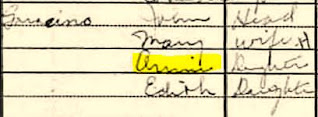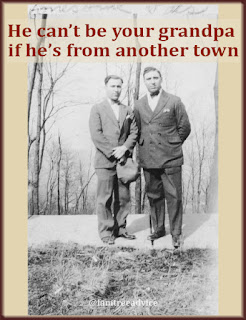31 January 2017
Where Have You Been All My Life?
29 January 2017
Case Study on "O Brother, Where Art Thou?"
26 January 2017
Case Study on "What If There's No There There?"
24 January 2017
Case Study on "Where Did Grandpa Come From?"
 |
| Once I found the town on a map, this was perfectly legible to me. |
22 January 2017
What If There's No There There?
 |
| Beautiful Pesco Sannita—formerly Pescolamazza. |
20 January 2017
O Brother, Where Art Thou?
You'll also enjoy:
17 January 2017
Haven’t I Seen You Before?
| My document tracker shows me what I have and what I'm missing in my family tree. |
16 January 2017
How Is That Possible?
15 January 2017
Where Did I Find This?
- Name
- Birth date
- Birth place
- Marriage date
- Death date
- Death place
- and more.
Where Did They Go Next?
 |
| Misspelled, but my family. |
14 January 2017
Who Are These People?
- The husband and wife had the correct first names.
- Their seven-year age difference matched all the other information I had.
- They had no children yet.
- The wife’s parents were living with them and had the same last name as their son-in-law. This was a fact I'd discovered on other documents, so here was further proof that the husband and wife had the same last name.
- The wife’s parents were named Victor and Angela, which matched the names of the couple’s first two children, seen on later census forms.
12 January 2017
Where Did Grandpa Come From?
- Ship manifests. I have a copy of the 1898 ship manifest that includes my great great grandparents and three of their children. That collection of names and ages is indisputable—there is no doubt they are my family. While my grandmother mentioned the town of Pastene many times, the ship manifest taught me something new. Pastene is a small section (a frazione) of a town called Sant’Angelo a Cupolo. That is the hometown on the ship manifest.
-
Naturalization papers. My cousin’s husband Enzo passed away recently, and in his obituary I found the names of his parents and brothers whom I didn't know personally. With these names I found Enzo’s father’s naturalization papers. This gave me a photograph of Enzo’s father as well as the Italian hometown of Enzo's parents.
That town name is the key to verifying any other documentation I may find for him. -
Passport applications. At certain times in U.S. history, your ancestor needed a passport to make sure he'd be allowed back in after visiting family in his homeland. A passport application can provide great information, including the name of your ancestor's father, his original hometown, and the names and birth dates of family members making the trip with him.
You may even score a photo of the whole family. - World War II draft registration cards. The same family that told me they came from Pastene would also say they came from Avellino. When I realized that Pastene is in Benevento, the province neighboring Avellino, I didn’t know what to make of this oral history fact.
It was the World War II draft registration card for one of the sons from this family that gave me the answer. The card said he was born in the town of Tufo in the province of Avellino. When I viewed Tufo vital records at a Family History Center, I found that my great great grandparents’ first two children (including one who died as a child) were born in Tufo. Then, for reasons unknown, they moved to Pastene where their next four children were born. -
Last name prevalence. You can use various websites to see if the last name of your ancestor is or was ever prevalent in what you think is their hometown. If your ancestor was Italian, you can visit http://www.gens.info/italia or https://www.cognomix.it/mappe-dei-cognomi-italiani to see where their last name is found.
I'm lucky to have a maiden name that is found in very, very few places in Italy. There's a really strong chance that someone with my maiden name is related to me. Find out What To Do When Your Last Name Is So Common.
11 January 2017
Welcome, Genealogy Fans
I want to share methods and tips to help you fortify your family tree. My years in the business world have taught me the value of following "best practices." That's what I'd like all genealogists to do.
If we each create high-quality, verifiable, ultra-fortified family trees, maybe someday it will be possible to link everyone on earth in an incomprehensibly large family tree chart. Only then can people say they’re related to every king and celebrity ever known…albeit distantly.
To help you fortify your family tree and give you the confidence to stand behind your research, I’ll share several best practices and principles for producing a truly high-quality family tree.
- Show us what you’ve found. Capture images of every genealogy document you find, and provide enough information to make your path to this discovery reproducible by other genealogists.
- Explain your sources. There are several books available on proper citation of genealogical sources. I prefer to keep it simple (e.g., “1930 U.S. Census” or “U.S. Social Security Death Index”). Provide enough detail so any other genealogical researcher can find the same item for themselves.
- Paint the entire picture. Completeness of records tells others that your information is accurate. Search every available Federal and state census for each family. Search military documentation for the men who were of age at the right time, ship manifests for every family member who traveled to another country, and birth, marriage and death records.

Your ancestors were captured in documents throughout their lives.
- Be consistent. Develop patterns in the language and style you use so you are giving facts and documenting your images in a consistent, logical, sensible way. This consistency will create reliability.
- Follow through. Develop a game plan that you can follow whenever you’re able to carve out some time for genealogy. Focusing on your plan will make you much more productive while fortifying your tree.
Join me as I detail these principles and practices and provide concrete examples that will increase the quality of your legacy—your family tree.













